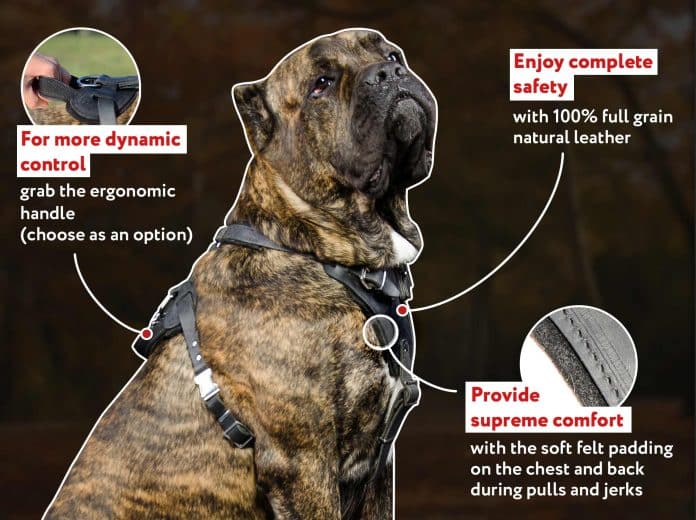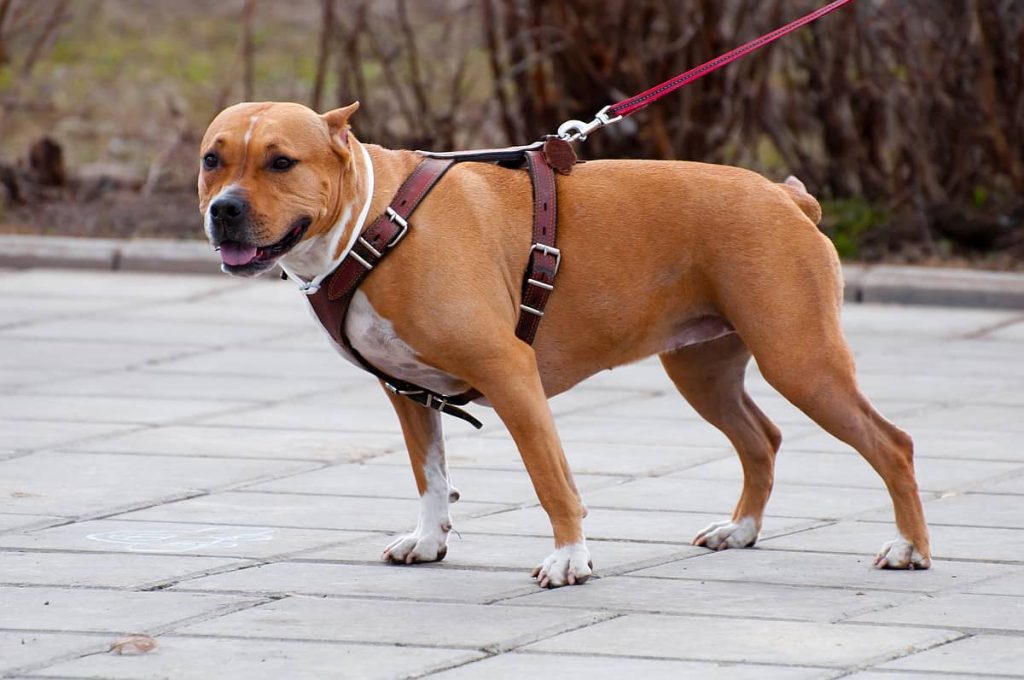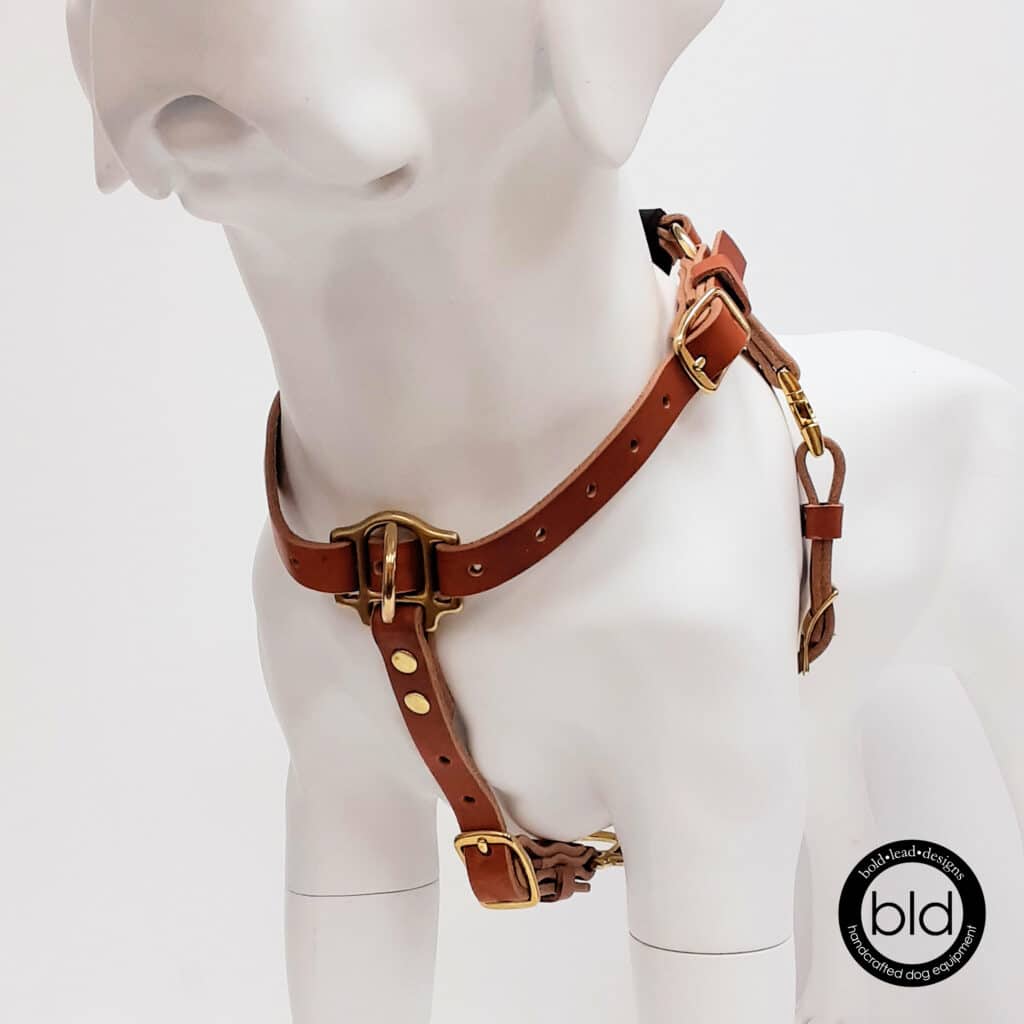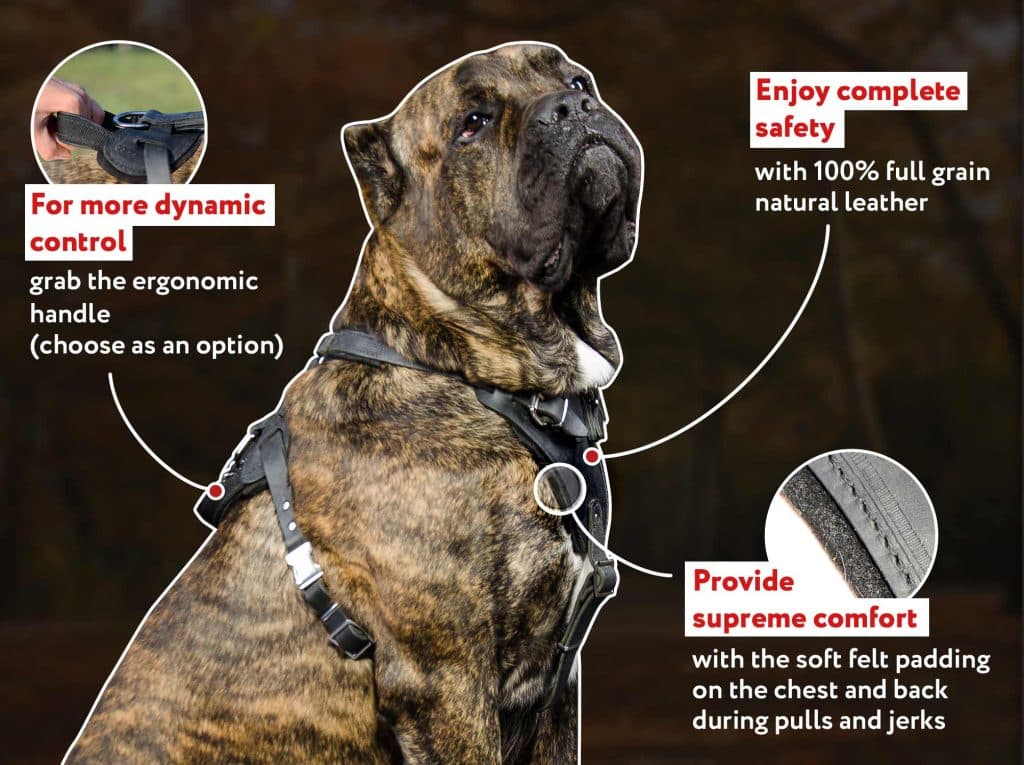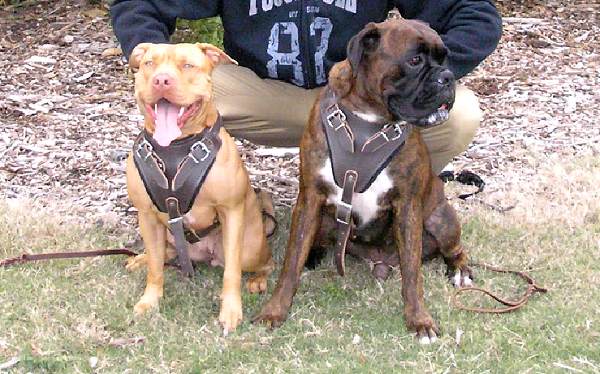Here’s the burning question on every dog owner’s mind: are leather harnesses bad for our beloved furry friends? As pet lovers, we always want what’s best for our four-legged companions, and choosing the correct harness is an important decision.
In this article, we’ll explore the potential drawbacks of leather harnesses, discussing their impact on our canine pals’ comfort, functionality, and overall well-being. So, let’s unravel the truth and make informed choices for our furry companions.
Leather Harnesses for Dogs
What are leather harnesses?
Leather harnesses for dogs are a type of dog harness made from high-quality leather material. They are designed to distribute the pressure from the leash evenly across the dog’s chest and shoulders, providing a more comfortable and secure fit than traditional collars. Leather harnesses typically consist of straps and buckles that can be adjusted to fit different breeds and sizes of dogs.
Advantages of leather harnesses
There are several advantages to using leather harnesses for dogs. Firstly, leather is a durable material that can withstand the wear and tear of daily use, making it a long-lasting choice for dog owners. Leather harnesses are also stylish, adding extra sophistication to your furry friend’s wardrobe. Additionally, leather is a natural and breathable material, allowing air to circulate through your dog’s body and preventing overheating during walks or outdoor activities.
Disadvantages of leather harnesses
While leather harnesses have many benefits, there are a few disadvantages that dog owners should consider. One potential issue is the impact on the dog’s skin. Some dogs may be sensitive or allergic to leather, leading to itching, redness, or irritation. Also, leather harnesses can somewhat restrict the dog’s movement, especially if not correctly fitted. This limitation may interfere with their natural range of motion and can be particularly problematic for highly active dogs or those involved in sports or agility training. Lastly, leather harnesses can cause pressure points and discomfort if not correctly adjusted or worn for extended periods.
Understanding the Safety Concerns
Potential impact on dog’s skin
One of the main safety concerns related to leather harnesses is their potential impact on a dog’s skin. Leather is natural, but some dogs may have allergies or sensitivities. If a dog reacts adversely to the leather, it can lead to itching, redness, or even skin irritation. It is essential to monitor your dog’s skin closely when using a leather harness and consult your veterinarian if any signs of discomfort or skin issues arise.
Restriction of movement
Another safety concern with leather harnesses is the potential restriction of a dog’s movement. While harnesses, in general, are designed to provide better control and distribute the force of pulling, leather harnesses can be less flexible than other materials. A leather harness that is too tight or poorly fitted can restrict the dog’s natural range of motion, hindering their ability to move freely. This can be problematic, especially for active or working dogs that require a wide range of movement.
Risk of chafing and irritation
Chafing and irritation are common concerns with any type of harness, including leather harnesses. If the harness is rubbing against the dog’s skin, especially in sensitive areas such as the armpits or chest, it can cause chafing or irritation. To minimize the risk, it is crucial to ensure that the leather harness is properly adjusted and fitted to the dog’s body. Regularly inspecting the harness and taking breaks during longer walks or activities can also help prevent chafing and irritation.
Pressure points and discomfort
Improperly fitted leather harnesses can also cause pressure points and discomfort for dogs. If the harness is too loose or tight in certain areas, it can create pressure points that dig into the dog’s skin and cause discomfort or pain. It is essential to regularly check the fit of the harness, make necessary adjustments, and ensure that it is not causing any discomfort for your furry companion.
This image is the property of www.k9ofmine.com.
Considerations for Dog Owners
Proper fit and sizing
When considering a leather harness for your dog, it is crucial to prioritize proper fit and sizing. Each dog is unique and may require a different size or style of harness. Measuring your dog’s chest and neck girth accurately is recommended before purchasing a leather harness. Choose a harness that allows adjustments and ensure it fits snugly but comfortably on your dog’s body. Properly fitting harnesses reduce the risk of chafing, discomfort, and restrictions on movement.
Material quality and durability
Not all leather harnesses are created equal in terms of quality and durability. It is essential to choose a leather harness made from high-quality materials that can withstand regular use and maintain its shape over time. Look for genuine, well-constructed leather harnesses with durable stitching and hardware. Investing in a high-quality leather harness will ensure longevity and provide your dog with a safer and more comfortable experience.
Alternative harness materials
If you have concerns about using a leather harness for your dog, alternative materials are available. Nylon or polyester harnesses are commonly used and offer similar benefits in durability and adjustability. Mesh or padded harnesses can provide extra comfort and reduce the risk of chafing. Vest-style harnesses are also an option, particularly for small or toy breeds that require minimal support. Explore different options, consider your dog’s needs, and choose a harness material that best suits their comfort and safety.
Benefits of Leather Harnesses
Durability and longevity
One of the significant benefits of leather harnesses is their durability and longevity. Leather is known for its strength and ability to withstand regular use. A well-made leather harness can outlast other materials, making it a cost-effective choice in the long run. While the initial investment may be higher, the durability of leather means you won’t have to replace the harness as frequently, saving you money and ensuring your dog has a reliable and sturdy harness.
Stylish and fashionable
Leather harnesses add style and sophistication to your dog’s appearance. Leather’s natural texture and elegance make it a popular choice among fashion-conscious dog owners. Whether you opt for a classic brown leather harness or a sleek black one, your dog will turn heads during walks or outings. Leather harnesses are also available in various designs, including embossed patterns and decorative studs, allowing you to choose a style that reflects your dog’s personality.
Ideal for certain dog breeds
Certain dog breeds benefit from the unique properties of leather harnesses. Breeds with short hair or sensitive skin can significantly benefit from leather’s breathability and natural moisture-wicking properties. With proper care and maintenance, leather harnesses can help prevent excessive heat or sweat buildup, reducing the risk of skin irritation. Additionally, leather harnesses can provide better support and control for dogs with shorter muzzles or those prone to respiratory issues, thanks to their frontal attachment point and chest coverage.
Natural and breathable material
Leather is a natural material that circulates air in your dog’s body, preventing overheating during walks or physical activities. Unlike synthetic materials that may trap heat and moisture, leather provides excellent breathability, keeping your dog comfortable in various weather conditions. The natural moisture-wicking properties of leather can help regulate body temperature and minimize the risk of skin irritations caused by trapped sweat or moisture.
This image is the property of boldleaddesigns.com.
Potential Health Issues
Allergies and skin sensitivities
One potential health issue when using a leather harness is the risk of allergies and skin sensitivities. Some dogs may have allergic reactions or sensitivities to leather, manifesting as itching, redness, rashes, or skin infections. It is essential to monitor your dog closely for any signs of discomfort or skin issues and consult your veterinarian if necessary. If your dog is prone to allergies or has sensitive skin, it may be advisable to consider alternative materials for their harness.
Impact on structural development
Proper structural development is crucial, especially in growing puppies. Leather harnesses, if too restrictive or improperly fitted, can hinder the natural movement and growth of a young dog’s body. It is essential to consult with your veterinarian or a professional dog trainer to ensure that the harness is fitted correctly and does not interfere with the dog’s structural development. Regularly assessing the fit of the harness as your puppy grows is also essential to avoid any negative impact on their physical development.
Breathing difficulties
Certain breeds, particularly those with short muzzles or respiratory issues, may experience breathing difficulties when wearing a harness. This can be a concern if the harness puts pressure on the dog’s neck or restricts their chest expansion. Choosing a leather harness that distributes the pressure evenly across the chest and has a front attachment point can alleviate breathing difficulties for these breeds. However, it is vital to carefully assess your dog’s breathing while using a harness and seek professional guidance if you notice any signs of respiratory distress.
Training Considerations
Positive reinforcement training
When using a leather harness for training, focusing on positive reinforcement techniques is recommended. Reward-based training methods involving treats, praise, and rewards are highly effective in encouraging desired behaviors and creating a positive association with the harness. This approach helps build trust and cooperation between you and your dog, making the training experience more enjoyable.
Proper leash attachment
Leash attachment is an essential aspect of using a harness. A front attachment point is recommended for most dogs, particularly those prone to pulling or lunging. A leather harness with a front attachment gives you better control and helps redirect your dog’s attention toward you when they start pulling. Proper leash attachment prevents excessive strain on the dog’s neck and reduces the risk of injury or discomfort during walks.
Behavioral impact
While leather harnesses can serve as practical tools for training, it is essential to consider their potential impact on your dog’s behavior. Some dogs may become more excitable or energetic when wearing a harness, associating it with outdoor activities and walks. Understanding and managing your dog’s behavior appropriately is crucial, ensuring they remain calm and focused during walks or training sessions. Consistency, patience, and positive reinforcement will go a long way in creating a well-behaved and well-adjusted dog.
This image is the property of i.insider.com.
Alternatives to Leather Harnesses
Nylon or polyester harnesses
Nylon and polyester harnesses are popular alternatives to leather harnesses. These materials offer durability, strength, and various design options. Nylon and polyester harnesses are adjustable and often feature quick-release buckles for easy on and off. They are lightweight, comfortable, and suitable for dogs of all sizes. They are generally more affordable than leather harnesses, making them a budget-friendly choice for dog owners.
Mesh or padded harnesses
For dog owners concerned about chafing or irritation, mesh or padded harnesses can be excellent alternatives. These harnesses feature soft padding or breathable mesh panels that provide cushioning and prevent rubbing against the dog’s skin. Mesh harnesses are particularly suitable for small or short-haired breeds, offering enhanced comfort and ventilation. Additionally, padded harnesses can prevent pressure points and distribute the force of leash pulling more evenly, promoting a more comfortable walking experience.
Vest-style harnesses
Vest-style harnesses are another alternative to consider. These harnesses cover a larger area of the dog’s body, distributing pressure more evenly. The vest design can provide added support and control, making it suitable for energetic or powerful dogs. Vest-style harnesses typically have multiple adjustable straps, allowing for a customized fit. They are easy to put on and take off, making them ideal for less patient dogs during the harnessing process.
Choosing the Right Harness for Your Dog
Understanding your dog’s needs
When choosing a harness for your dog, it is essential to consider their specific needs and characteristics. Consider your dog’s size, breed, activity level, and potential health concerns. For example, a mesh harness may be an excellent choice for ensuring their comfort if you have a small dog with short hair. Similarly, if your dog tends to pull excessively, a front-attachment harness can aid in training and control. Understanding your dog’s needs will help you make an informed decision and select a harness that suits their requirements.
Consulting with a veterinarian or trainer
If you have any concerns or specific questions about using a leather harness for your dog, it is always advisable to consult with a veterinarian or a professional dog trainer. They can assess your dog’s unique needs, offer recommendations, and provide guidance on proper fit and usage. Your veterinarian can also advise on any potential health issues or risks associated with using a leather harness, ensuring the safety and well-being of your furry companion.
Considering the activity or purpose
When selecting the right one for your dog, the intended activity or purpose for using a harness should also be considered. A durable and secure harness is essential if you plan on engaging in outdoor adventures or sports activities. Alternatively, if your dog’s primary use for the harness is daily walks or outings, factors such as comfort, temperature regulation, and ease of use may be more critical. You can choose a harness that best meets your dog’s needs by considering the specific activity or purpose.
This image is the property of www.cane-corso-dog-breed-store.com.
Proper Maintenance and Care
Cleaning leather harnesses
Proper maintenance and care are essential to prolong the life of a leather harness. To clean a leather harness, use a damp cloth or sponge with mild soap or leather cleaner to wipe away dirt or stains. Avoid using harsh chemicals or excessive water. After cleaning, ensure the harness is thoroughly dry before storing or using it again. Regularly cleaning your leather harness will help maintain its appearance and prevent dirt or bacteria buildup, ensuring a hygienic and safe experience for your dog.
Conditioning and moisturizing
Conditioning and moisturizing are recommended to keep a leather harness supple and prevent cracking or drying. Apply a leather conditioner or natural oil such as neatsfoot or coconut oil to the harness and gently rub it into the leather using a soft cloth. Conditioning helps retain the natural oils in the leather and prevents it from becoming brittle or stiff. However, following the manufacturer’s instructions and using products specifically designed for leather to avoid any damage or adverse effects is essential.
Inspecting for damage
Regularly inspecting your dog’s leather harness is crucial to ensure its safety and functionality. Look for signs of wear and tear, such as loose stitching, frayed edges, or cracked leather. Check the buckles, D-rings, and straps for any signs of damage or weakness. If you notice any defects or structural issues, it is essential to replace the harness immediately to prevent accidents or injuries. Regular inspections contribute to the long-term durability and effectiveness of your dog’s leather harness.
Conclusion
When considering a leather harness for your dog, it is essential to weigh the advantages and disadvantages, as well as the potential safety concerns and health issues. While leather harnesses offer durability, style, and comfort, they may not suit all dogs, especially those with allergies or specific mobility requirements. Understanding your dog’s needs, consulting with professionals, and considering alternative materials can help you make an informed decision and choose the correct harness for your furry friend.
Proper fit, maintenance, and regular inspections ensure the safety and well-being of your dog during walks, training, and other activities. Considering all the factors involved, you can provide your dog with a safe and comfortable harnessing experience that enhances the bond between you and your four-legged companion.
This image is the property of www.fordogtrainers.com.

